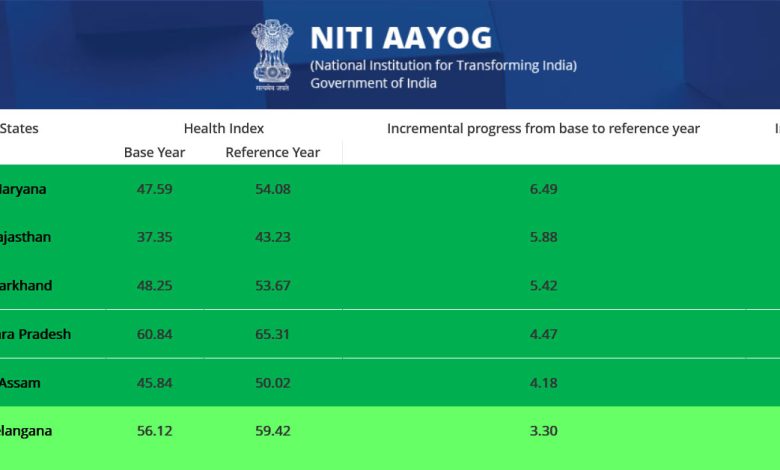Daily Current Affairs for UPSC
NITI Aayog’s annual ‘health index’
Syllabus- Government Policies and Interventions [GS Paper-2]

Context- In the NITI Aayog’s annual “health index” for the Covid year of 2020-21, Kerala, Tamil Nadu, and Telangana emerged as the best performers among the “larger states.”
Key Highlights
Based on Overall Performance:
- Larger States:
-
-
- In terms of overall performance, Kerala, Tamil Nadu, and Telangana have occupied first, second, and third place, respectively, among the 19 “larger states.”
- At the bottom of the list are Madhya Pradesh (17th), Uttar Pradesh (18th), and Bihar (19th).
-
- Smaller States:
-
-
- Among the eight more modest states, Tripura has recorded the best by and large execution, trailed by Sikkim and Goa; Arunachal Pradesh (sixth), Nagaland (seventh) and Manipur (eighth) are at the base.
-
- Union Territories(UT):
-
-
- Furthermore, among the eight UTs, Lakshadweep has been positioned as the top entertainer with regards to general execution, while Delhi is positioned at the base.
-
- Based on Performance Improvement:
-
- Rajasthan, Uttarakhand and Odisha arose as the best three entertainers in 2020-21, when contrasted with their presentation in 2019-20.
What is the annual health index from NITI Aayog?
- About:
-
-
- An annual Health Index was launched in 2017 by the National Institution for Transforming India (NITI Aayog), the Ministry of Health and Family Welfare (MoHFW), and the World Bank to track both overall and incremental performance across all states and Union Territories (UTs).
-
- Objective:
-
-
- The Annual Health Index’s goals are to track and rank progress on health outcomes and system performance, foster healthy competition, and promote cross-UT learning.
-
- Parameters:
-
-
- The health index evaluates states and UTs based on two factors:
- overall performance and incremental performance, or
- progress over time.
- The health index evaluates states and UTs based on two factors:
-
- Categories:
-
-
- The positioning is finished under three classifications: larger states, smaller states, and Union territories (UTs) to make sure similar entities can be compared.
-
- Composition:
-
- The states and UTs’ accomplishments and incremental progress on 24 indicators across three domains are reflected in the Health Index, a composite score: health outcomes, information governance, key inputs, and procedures
- Every space has been doled out weight in view of its significance with a higher score for result pointers.
- The ‘health outcomes’ incorporate markers like neonatal death rate, complete ripeness rate, sex proportion upon entering the world, inoculation inclusion, extent of institutional conveyances, absolute case notice pace of tuberculosis, and extent of individuals living with HIV on antiretroviral treatment.
- The ‘governance and information’ area incorporates markers like extent of institutional conveyances, normal inhabitants (in long stretches) of three critical posts at state level, normal inhabitants (in months) of the main clinical official, and days taken for store move.
- A measure of the health infrastructure that is available is the “key inputs/ processes,” which include the proportion of districts with functional cardiac care units, functional 24×7 primary healthcare centers, and vacant healthcare provider positions.





.png)



